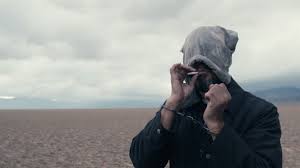Rotterdam 2024 Review: STEPPENWOLF, No Country for Sane Men
Kazakh filmmaker Adilkhan Yerzhanov delivers his most nihilistic work to date.

Kazakh director Adilkhan Yerzhanov belongs among the small coterie of highly prolific contemporary indie filmmakers, such as Quentin Dupieux, as he expands his filmography with Steppenwolf, his 15th feature film in 12 years. His latest, embedded in the director's fictional Karatas universe, furthers his exploration of human resilience in the face of adversity and corruption.
Known for a filmography that oscillates between genres — from absurd tragicomedies like Yellow Cat to the more upbeat Ademoka's Education, and extending to intense bleak dramas such as Dark, Dark Man and Assault — Yerzhanov demonstrates a versatile directorial range. With Steppenwolf, lifting its title from Herman Hesse's acclaimed novel, he ventures into even darker territory, marking a significant shift towards greater intensity. Arguably, it's his most somber and nihilistic work to date.
The film opens amidst riots, with Tamara, a perplexed and inarticulate mother, searching for her missing son. Navigating through the chaos on the streets, she finds herself in a police station witnessing a brutal assault. Here, she encounters an ex-convict who has been coerced by the police into becoming a sadistic interrogation officer.
In a turn of events, Tamara inadvertently becomes a lifeline for the unscrupulous interrogation officer, the titular Steppenwolf, rescuing him from imminent execution at the hands of rioters. Leveraging the situation, Steppenwolf convinces the rioters that Tamara will reward them handsomely for finding her son, leading them to agree to search for the child. This collective pursuit gradually escalates into a last man standing situation, revealing Steppenwolf's actual agenda.
As Steppenwolf arrives after Goliath, it appears to be its spiritual sequel. Goliath, an austere revenge Western, portrays the subversion of tyranny in a deadpan, anti-climactic style. The film follows a stuttering, disabled protagonist working for a ruthless crime lord responsible for his wife's death. Despite lacking a direct incentive to challenge the tyrannical "Goliath," the protagonist is compelled by a moral impetus, balancing his need to provide for his daughter.
Steppenwolf expands upon this storytelling landscape, introducing a more nihilistic dimension. The character of Tamara represents the exploited common folk under the dominion of a local elite, with a child trafficker at the apex. Steppenwolf, in contrast to his previous incarnation as Goliath, operates from society's fringes as an outcast.The central characters form an unlikely alliance on a perilous rescue mission.
In addition, both films augment their narratives by referencing classic literature; Steppenwolf draws from Hesse's novel, while Goliath incorporates motifs and quotes from Niccolò Machiavelli's The Prince.
Yerzhanov continues to employ his characteristic blend of minimalism, realism, and absurdism within an austere aesthetic framework. The storytelling, linear and direct, is paired with stark, unflinching action. As the story unfolds, Yerzhanov gradually unveils the complexities of his characters: Tamara, who harbors depths beyond her initial appearance, and Steppenwolf, who maintains a vestige of humanity.
The film's title and Steppenwolf's moniker, derived from Hesse's exploration of the dual nature of humanity — spiritual and animalistic — mirror the protagonist's struggle between these facets. Yerzhanov's stories in the expansive Karatas universe often portrays individuals mired in moral and social decay, unflinchingly addressing transgressive and taboo subjects such as school shootings, child abuse, and trafficking.
The director's prolific output, consistently delivering a film annually, seems to reflect the broader mood of prevailing global affairs. This context lends insight into why Steppenwolf emerges as his bleakest work to date, engaging with socio-existential themes that resonate with contemporary concerns.
In Yerzhanov's body of work, Steppenwolf emerges as a stark contrast to his earlier film, a rather slapstick Yellow Cat, which shares thematic elements with Terrence Malick's Badlands. While Yellow Cat is imbued with a dreamlike naiveté and dark undertones, Steppenwolf delves into deeper shades of darkness.
Yerzhanov's approach transforms the Badlands subject into an actual Mad Max ride, set against the backdrop of the Kazakh steppes and desolate villages. The film characterizes its protagonist's rampage as both cold-hearted and methodical, morphing from the coolness of Kit Carruthers in Badlands to No Country for Old Men's sociopathic Anton Chigurh.
Yerzhanov's inclination to blend genres is evident as Steppenwolf transitions through various genres, including a road movie, a samurai movie, a mobster movie, a dystopic thriller and a revenge drama. As a nihilistic pendant to Yellow Cat, Steppenwolf is Yerzhanov's unique take on a "steppe gothic" in an intricate blend of exploitational morality.
The film enjoys its world premiere at International Film Festival Rotterdam.









